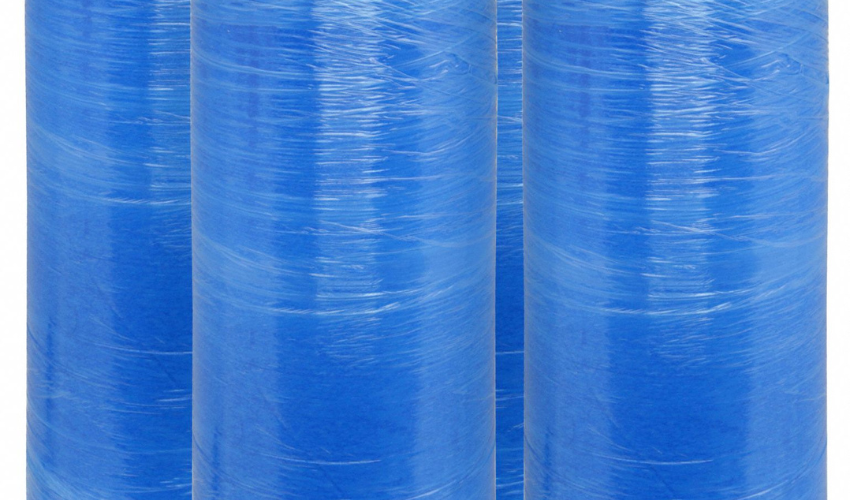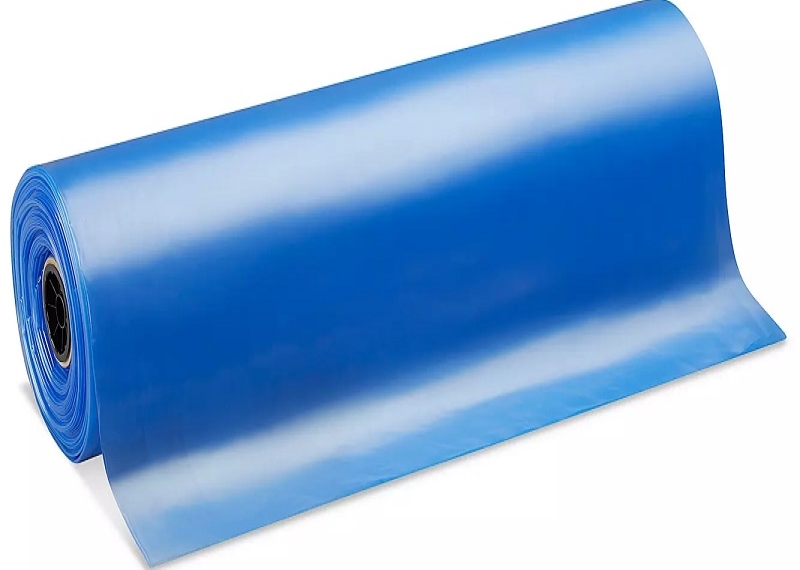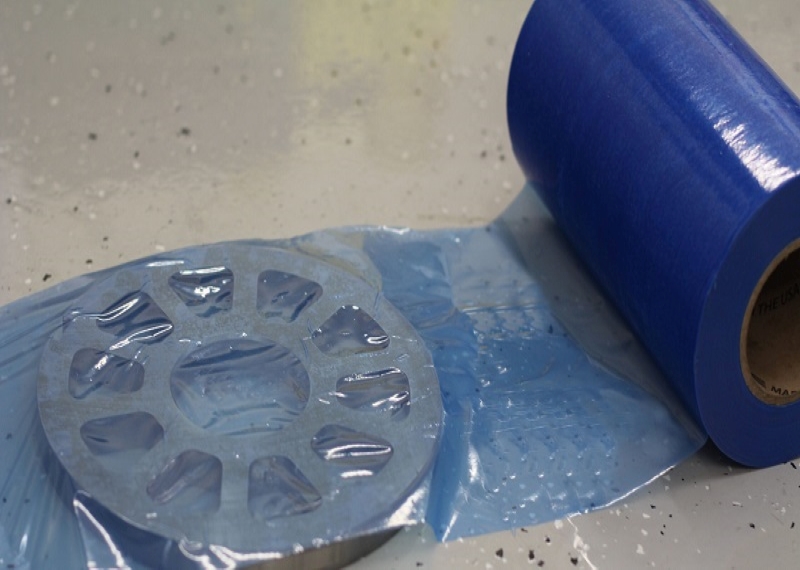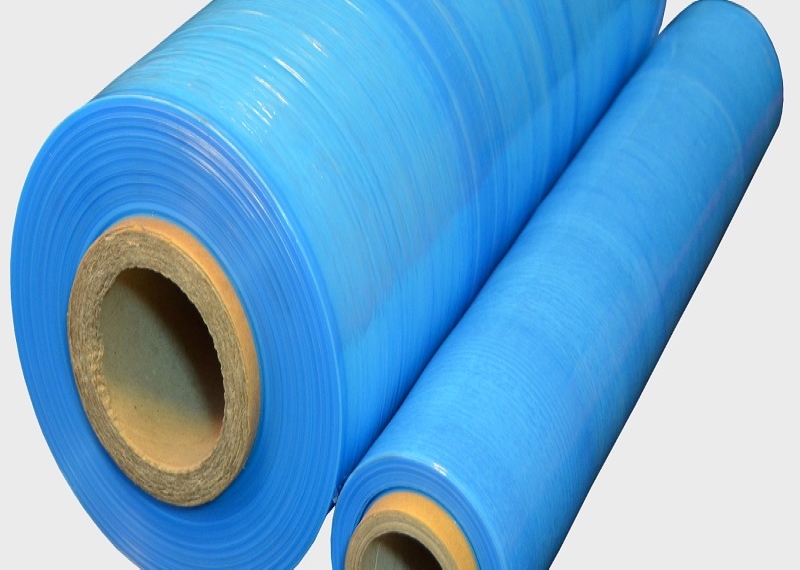
VCI film, or Vapor Corrosion Inhibitor film, is a specialized packaging solution designed to protect metal surfaces from corrosion. It functions by releasing vaporized corrosion inhibitors that form a protective layer on the metal, preventing moisture and contaminants from causing rust and deterioration. This dual-action approach makes VCI film essential for various industries, where metal components are often at risk during storage and transit. By utilizing VCI film, businesses can significantly extend the lifespan of their metal parts, ensuring they remain clean and ready for use when needed. The importance of VCI film lies in its ability to provide reliable, long-term protection against the damaging effects of corrosion. VCI film, made of polyethylene with vapor inhibitors, offers excellent corrosion protection, clean packaging, and easy identification for metal parts.
VCI film provides a multitude of benefits for metal protection, making it an essential choice for industries that rely on metal components. Its unique properties not only protect against corrosion but also contribute to overall efficiency and cost-effectiveness in operations.

VCI film acts as a robust physical barrier that prevents dust, moisture, and contaminants from reaching metal surfaces. By forming a protective layer, it minimizes direct contact with environmental factors that can lead to rust and corrosion. Additionally, film vci releases corrosion-inhibiting vapors that permeate the enclosed space, creating a molecular shield around the metal. This dual-action approach ensures that metal parts remain in optimal condition during storage and transport.
The versatility of VCI film makes it suitable for a wide range of metals, each benefiting from its protective qualities. Here are some key advantages:
Comprehensive Protection: VCI film is effective for metals such as steel, aluminum, copper, and brass, providing tailored protection depending on the metal’s susceptibility to corrosion.
Long-Term Efficacy: With proper use, VCI rust preventive stretch film produced by a specialized VCI antirust stretch film factory can protect metal parts for extended periods, often up to three years or more. This ensures that components remain rust-free until they are needed, providing effective corrosion protection over long durations.
Clean Surface Maintenance: Unlike traditional coatings, VCI film leaves no greasy residue on the metal surface after removal. This means that parts are ready for immediate use without the need for further cleaning or degreasing.
Cost-Effective Solution: Utilizing VCI film can lead to significant cost savings by reducing the need for rework or replacement of corroded parts, ultimately enhancing operational efficiency.
By incorporating VCI film into packaging and storage practices, industries can ensure the longevity and reliability of their metal products. The unique properties of VCI film not only safeguard valuable assets but also enhance overall operational efficiency, making it an indispensable tool in corrosion prevention.
VCI film, or Vapor Corrosion Inhibitor film, is a specialized packaging material designed to protect metal surfaces from corrosion and rust. This innovative film contains chemical compounds that release vapors, which form a protective layer on exposed metal. The effectiveness of VCI film in corrosion prevention is attributed to its unique composition and the way it interacts with the environment surrounding the metal.
VCI film works by releasing corrosion-inhibiting vapors that condense on metal surfaces, creating a molecular shield that protects against moisture, oxygen, and other corrosive elements. This film is made from polyethylene and is impregnated with specific VCI chemicals that vary by manufacturer, allowing it to target various types of metals.
The effectiveness of VCI film can be summarized through the following key points:
Corrosion Protection: VCI antirust stretch film manufacturers have developed this material to effectively inhibit rust and corrosion on a variety of metals, including steel, aluminum, copper, and brass. The film releases volatile corrosion inhibitors that form a protective layer on the metal surfaces, making it an ideal choice for industries that handle different metal components.
Long-lasting Defense: With proper usage, VCI film can provide protection for extended periods—often up to three years—ensuring that metal parts remain in excellent condition during storage and transportation.
Ease of Use: VCI film is straightforward to apply, requiring no special equipment or processes. Simply wrapping the metal parts in VCI film provides immediate corrosion protection.
Cleanliness: After removal, the anti-rust vci stretch film leaves no oily residues on the metal surfaces, allowing for immediate use without the need for cleaning or degreasing.
VCI stretch film is a specific type of VCI film that combines the protective properties of VCI with the elasticity of stretch film. This variant is particularly beneficial for wrapping larger or irregularly shaped metal items, offering both protection and versatility in application.
The applications of VCI stretch film include:
Shipping and Storage: VCI stretch film is widely used for packaging metal parts during shipping, ensuring that they are safeguarded against corrosion and environmental factors throughout their journey.
Industrial Use: Many manufacturing facilities utilize VCI stretch film for wrapping machinery and equipment, protecting them from moisture and contaminants during storage or transit.
Automotive Industry: In the automotive sector, VCI stretch film is employed to protect metal components such as engine parts and frames, which are susceptible to rust.
Electronics Protection: VCI stretch film is also valuable for packaging electronic components that may include metal parts, preventing corrosion that could affect functionality.
VCI film serves as a vital solution for corrosion prevention, offering effective protection for various types of metals through its unique vapor-releasing technology. VCI stretch film extends these benefits to larger items and industrial applications, making it an essential tool in many industries. By choosing VCI film, businesses can ensure the integrity and longevity of their metal components, ultimately leading to cost savings and enhanced operational efficiency.
VCI film offers a variety of options tailored to meet the specific needs of different industries. Among these options, VCI plastic bags stand out as a popular choice due to their versatility and effectiveness in corrosion prevention. Understanding the types of VCI plastic bags available and their specific uses can help businesses select the most appropriate solution for their metal protection needs.
VCI plastic bags come in several forms, each designed for unique applications. Here are some common types:
Standard VCI Bags: These are general-purpose bags made from polyethylene and infused with VCI chemicals. They are suitable for packaging small to medium-sized metal parts, providing effective corrosion protection.
Heavy-Duty VCI Bags: Designed for larger or heavier items, heavy-duty VCI bags offer enhanced thickness and durability. They are ideal for shipping robust metal components, such as machinery parts or tools.
Zippered VCI Bags: These bags feature a zipper closure, allowing for easy access and reusability. They are particularly useful for items that may need to be retrieved multiple times while still requiring corrosion protection.
Heat-Sealable VCI Bags: These bags can be heat-sealed for an airtight closure, providing maximum protection against environmental factors. They are often used in long-term storage situations or for high-value items.
Using VCI plastic bags, similar to shipping plastic wrap, offers numerous advantages for businesses involved in shipping and storage of metal components. The benefits include:
Corrosion Prevention: VCI plastic bags effectively protect against moisture and contaminants, ensuring that metal parts remain rust-free during transport and storage.
Ease of Handling: Lightweight and flexible, VCI plastic bags are easy to handle, making packaging and unpackaging efficient and convenient.
Cost-Effectiveness: Compared to traditional rust prevention methods, VCI plastic bags provide a more economical solution for corrosion protection, reducing potential losses from damaged parts.
Versatility: VCI plastic bags can be used in various industries, including automotive, electronics, and manufacturing, accommodating a wide range of metal components.
Reduced Cleanup: Unlike traditional protective coatings that may leave residues, VCI plastic bags keep metal surfaces clean and ready for immediate use upon removal.
Exploring the options available within the realm of VCI film, particularly VCI plastic bags, reveals a versatile solution for corrosion prevention in various industries. The different types of VCI plastic bags cater to specific needs, ensuring effective protection for metal components during shipping and storage. By leveraging the advantages of VCI plastic bags, businesses can enhance operational efficiency, reduce costs, and ensure the longevity of their metal products. This makes VCI film an invaluable resource in the ongoing fight against corrosion.
VCI heat shrink film is an advanced packaging solution that combines the protective benefits of VCI technology with the durability of heat shrink materials. This film, also offering stretch film security, is designed to create a tight, protective barrier around metal components, ensuring maximum protection against corrosion and environmental damage.

VCI heat shrink film is made from high-quality polymers infused with vapor corrosion inhibitors. When heat is applied, the shrink wrap film shrinks tightly around the item being wrapped, conforming to its shape and creating a secure, protective layer. The unique properties of VCI heat shrink film include:
Tight Fit: The heat shrink process allows for a snug fit around various shapes and sizes of metal components, minimizing movement and potential exposure to contaminants.
Vapor Release: As with other VCI films, this type releases corrosion-inhibiting vapors that form a protective layer on the metal surface, safeguarding it from rust and deterioration.
Transparency: VCI heat shrink film is often transparent, allowing for easy visibility of the wrapped items while still providing effective protection.
Resistance to Punctures and Tears: The material is designed to be robust, offering resistance against punctures, tears, and other forms of damage during handling and transportation.
VCI heat shrink film is particularly well-suited for a variety of applications across different industries. Its benefits can be summarized as follows:
Heavy Machinery and Equipment: Ideal for protecting large machinery parts, such as engines and transmissions, during shipping and storage, VCI heat shrink film ensures these valuable components remain in excellent condition.
Long-Term Storage: When items need to be stored for extended periods, VCI heat shrink film offers a reliable solution to prevent corrosion while maintaining the integrity of the packaging.
Complex Shapes: The film’s ability to shrink tightly around irregularly shaped items makes it perfect for items with intricate designs or components that need special handling.
Environmental Protection: By creating a barrier against moisture, dust, and pollutants, VCI heat shrink film helps maintain the cleanliness of the items wrapped within it.
VCI heat shrink film stands out as a superior choice for maximum protection of metal components. Its unique properties, including a snug fit and effective vapor release, ensure that items remain free from corrosion and environmental damage. With a wide range of ideal applications, VCI heat shrink film is an essential packaging solution for businesses looking to enhance the longevity and reliability of their metal products. By incorporating VCI heat shrink film into their packaging processes, companies can achieve significant benefits in both performance and cost savings.
When considering VCI film for protecting metal components, understanding the pricing landscape is essential. VCI film prices can vary significantly based on several factors, which can influence purchasing decisions for businesses looking to invest in corrosion protection.
Several key factors can affect the price of VCI film, including:
Material Quality: Higher-quality materials often lead to increased durability and effectiveness, but they also tend to come at a higher price point. Films made from advanced polymers with superior corrosion inhibition properties usually cost more.
Film Thickness: Thicker VCI films generally offer better protection and may cost more than thinner options. Businesses should weigh the benefits of added protection against budget considerations.
Type of VCI Film: Different types of VCI films—such as heat shrink, stretch, or plastic bags—come with varying manufacturing costs, which can impact their retail prices.
Brand Reputation: Established brands with a proven track record may charge a premium for their products. Companies may feel more secure investing in well-known brands due to perceived reliability and performance.
Order Quantity: Purchasing VCI film in bulk can often lead to significant cost savings per unit. Volume discounts are common in the packaging industry, making it more economical for businesses to stock up on needed materials.
To provide a clearer picture of what to expect in terms of pricing, here’s a comparison of average costs for various types of VCI film across different brands:
| Type of VCI Film | Price Range (per roll) | Notes |
|---|---|---|
| Standard VCI Film | $50 - $100 | Basic protection, commonly used. |
| Heavy-Duty VCI Film | $100 - $200 | Thicker and more robust for heavy items. |
| VCI Heat Shrink Film | $75 - $150 | Provides a tight fit for irregular shapes. |
| VCI Plastic Bags | $20 - $60 per box (100 bags) | Economical option for smaller parts. |
Understanding the pricing of VCI film involves examining various factors that influence costs, such as material quality, film thickness, type, brand reputation, and order quantity. By comparing prices across different types and brands, businesses can make informed decisions that balance cost and effectiveness. Investing in the right VCI film is essential for ensuring the longevity and reliability of metal components, ultimately leading to better operational efficiency and reduced maintenance costs.
The production of VCI film is a sophisticated process designed to create a high-quality, durable packaging solution that effectively protects metal products from corrosion. Below is a detailed breakdown of each step:
The process begins with the selection and preparation of high-grade polyethylene resin. This resin serves as the primary raw material for the film, chosen for its flexibility, durability, and ability to form a uniform structure. The resin is thoroughly inspected to ensure it meets quality standards, as the base material directly impacts the film’s performance.
Vapor corrosion inhibitor (VCI) chemicals, typically in granular or liquid form, are precisely measured and mixed with the polyethylene resin. This blending process ensures an even distribution of VCI molecules throughout the material. The inhibitors are designed to release vapor molecules over time, forming a protective barrier on metal surfaces against moisture, oxygen, and other corrosive elements.
The blended material is fed into an extrusion machine where it is heated to a molten state. The mixture is then forced through a die to form a thin, continuous sheet of film. This step is critical for achieving a uniform thickness and ensuring the VCI chemicals are embedded evenly within the structure of the film.
After extrusion, the film passes through cooling rollers to solidify its structure. It is then stretched to achieve the desired thickness and mechanical properties, such as tensile strength and flexibility. This process is carefully controlled to maintain consistent quality and performance across the entire film.
During or after the extrusion process, a transparent blue tint is added to the film for easy identification. Other additives, such as UV stabilizers or anti-static agents, may also be incorporated to enhance the film’s functionality, depending on the intended application.
Before proceeding to the final stage, the film undergoes rigorous quality checks. These tests evaluate parameters such as thickness, tensile strength, VCI efficacy, and uniformity. Samples are tested in simulated conditions to ensure the film provides reliable corrosion protection.
Once the film meets all quality standards, it is cut into rolls, sheets, or other specified formats. The finished product is then securely packaged to preserve its properties and prepared for distribution to end-users or industrial applications.
This detailed process ensures that VCI film meets stringent performance requirements, providing an effective and reliable solution for protecting metal products during storage and transport.
VCI film is crafted from a combination of high-quality materials that ensure its effectiveness as a corrosion-protection solution.

Below is a detailed description of the materials used:
Polyethylene resin is the primary material used in VCI film production. It is a lightweight, flexible, and durable thermoplastic polymer. This resin provides the structural foundation for the film, ensuring it is strong enough to protect metal products while remaining pliable for easy wrapping. Polyethylene is also resistant to moisture and chemicals, making it an ideal base material for VCI films used in industrial and shipping environments.
VCI chemicals are the active components that provide the corrosion protection properties of the film. These chemicals are specially formulated to release vapor molecules that condense on the surface of metals, creating an invisible, molecular-level shield against oxidation, moisture, and other corrosive agents. Common VCI compounds include organic amines, carboxylates, and nitrites (depending on the formulation and metal type being protected).
VCI films often feature a transparent blue tint for easy identification. This is achieved by adding non-reactive, color-safe dyes to the material during production. These additives do not affect the film’s protective properties but improve its usability and visibility in industrial applications.
Additional additives are sometimes included to enhance specific properties of the VCI film. Examples include:
To ensure consistent performance during manufacturing and usage, stabilizers and processing aids are incorporated. These materials help maintain the integrity of the film under varying environmental conditions and during the extrusion process.
The combination of these materials ensures that VCI film is a reliable, versatile, and effective solution for protecting metal products from rust and corrosion in storage or transit.
VCI film operates based on the principle of vapor-phase corrosion inhibition, which protects metal surfaces from rust and corrosion. Here’s a detailed explanation of its working mechanism:
Release of VCI Molecules
VCI film is infused with vapor corrosion inhibitor (VCI) chemicals. When the film is exposed to the surrounding environment, these inhibitors release vapor-phase molecules into the air within the enclosed packaging. The release occurs gradually, ensuring long-term protection.
Formation of a Protective Layer
The vapor molecules emitted by the VCI film travel and settle on the exposed metal surfaces within the packaging. These molecules form an invisible, thin, and molecular-level protective layer. This layer effectively prevents oxygen, moisture, and other corrosive elements from coming into direct contact with the metal surface.
Inhibition of Corrosion Reactions
The VCI molecules disrupt the electrochemical reactions that cause rust and corrosion. By neutralizing moisture and oxygen at the molecular level, the VCI layer stops the oxidation process, which is the primary cause of metal degradation.
Dynamic Protection
One of the key advantages of VCI film is its dynamic protection. The vapor-phase inhibitors are self-replenishing, meaning if the packaging is momentarily opened or disturbed, the VCI molecules will continue to release and restore the protective layer once the environment is resealed.
Clean and Residue-Free
Unlike traditional anti-corrosion methods, such as applying oil or grease, VCI film provides clean protection without leaving any residue on the metal surface. This eliminates the need for cleaning before use and simplifies handling.
This working principle makes VCI film an efficient and practical solution for protecting a wide range of metal products, including tools, machinery, and automotive components, during storage and transportation.
VCI film, or Vapor Corrosion Inhibitor film, is a specialized type of packaging material designed to protect metal components from corrosion. It is made from polyethylene and infused with VCI chemicals that release vapor to form a protective barrier on the surface of metal objects. This barrier inhibits the oxidation process, effectively preventing rust and corrosion. The film can be used in various forms, including rolls, sheets, and bags, and is suitable for a wide range of applications across industries such as automotive, aerospace, and manufacturing. By wrapping metal parts in VCI film, businesses can ensure that their products remain in optimal condition during storage and transportation, reducing the risk of damage due to environmental factors.
In packaging, VCI stands for Vapor Corrosion Inhibitor. This term refers to a specific type of chemical technology used to prevent corrosion on metal surfaces within sealed environments. VCI substances are incorporated into packaging materials, such as films and papers, to release vapors that settle on the surfaces of enclosed metal objects. These vapors create a protective molecular layer that effectively shields the metals from moisture, oxygen, and other corrosive elements in the air. VCI technology is especially beneficial for industries that deal with sensitive metal components, ensuring that products remain rust-free and in pristine condition during storage and shipping. Utilizing VCI packaging can lead to significant cost savings by minimizing the risk of corrosion-related damage.
The primary purpose of VCI is to protect metal surfaces from corrosion and rust, which can occur due to exposure to moisture and other environmental factors. VCI technology accomplishes this by releasing vapors that form a protective layer on the metal’s surface, effectively blocking corrosive elements. This is particularly important for industries that manufacture or handle metal components, as corrosion can lead to significant financial losses and safety hazards. VCI is also used in various applications, from packaging and shipping to long-term storage, ensuring that metal parts remain functional and visually appealing. Additionally, VCI technology helps companies comply with quality standards and regulations, promoting better product integrity. By employing VCI solutions, businesses can enhance the longevity of their metal products and reduce the need for costly repairs or replacements due to corrosion damage.
VCI coating refers to a protective layer that integrates vapor corrosion inhibitor (VCI) technology to shield metal surfaces from rust and corrosion. Applied to VCI films, this coating releases vapor molecules that form an invisible layer on the surface of metal products, preventing oxidation and moisture-related damage. The VCI coating enhances the film’s ability to protect metals during storage or transit by creating a dry, clean, and effective barrier. This coating is especially beneficial for sensitive mechanical parts and tools, ensuring long-lasting protection without the need for additional greases or oils.
VCI stands for Vapor Corrosion Inhibitor. This technology is a chemical solution used in packaging materials like VCI films to prevent metal corrosion. It works by releasing vapor molecules that create a protective shield on metal surfaces, guarding them from moisture, oxygen, and other corrosive elements.
VCI film, similar to VCI paper, typically offers effective corrosion protection for up to 2 years under ideal conditions. This duration depends on factors such as storage environment, humidity, and the type of metal being protected. Properly sealed packaging ensures maximum performance.
When using VCI film in place of paper, wrap the metal item fully, ensuring direct contact for optimal protection. Seal the packaging tightly to trap the protective vapors and minimize exposure to air or moisture.
VCI film, like VCI paper, is used for protecting metal products from corrosion during storage or shipping. It’s ideal for automotive parts, machinery, and tools.
For VCI film users, the preferred response is to store metal items in clean, dry conditions, fully sealed within the film for maximum corrosion protection.

My name is James Thompson, and I’m the editor of this website dedicated to Stretch Film, Pallet Wrap, and Stretch Wrap products.
My passion for packaging began when I noticed the challenges companies face in securing their products efficiently for transportation and storage. This inspired me to delve deep into the world of stretch films and pallet wraps, exploring the latest technologies and best practices.
I aim to provide valuable insights, practical tips, and up-to-date industry trends to assist you in making informed decisions. Whether you’re a small business owner or part of a large corporation, my goal is to support you in optimizing your operations and ensuring your products reach their destination safely.
Thank you for visiting, and I look forward to accompanying you on your journey toward better packaging solutions.
Comments are closed